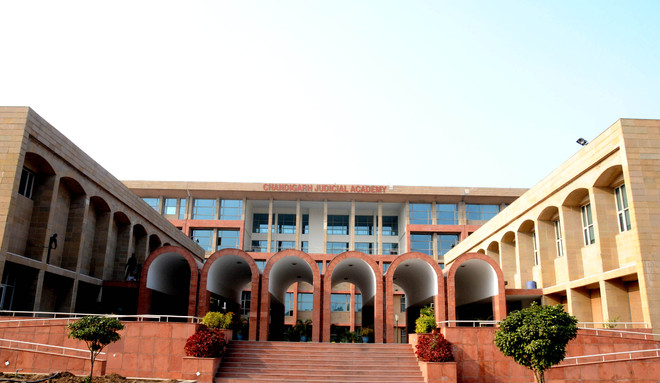Saurabh Malik
Clearing an examination can make lawyer a judicial officer. But to become a judge, you need something more.
A judicial officer in a remote district of Punjab was pondering over an answer to a grave problem in hand. A man missing for seven years had to be declared dead. But was a suit only against the general public, without making others a party, the solution? A wrong judgment in the case would have far reaching and deadly repercussions.
In another part of the region, a young judicial officer was trying to balance law and judicial responsibilities on the scales of ethics. As a judicial magistrate, he had recorded a rape victim’s statement before the beginning of trial. His frantic mind was trying to analyse whether holding a trial in a case, where the victim’s statement had already been recorded by him, would amount to pre-judging the matter. Consultations only enhanced confusion! If only there was someone to deliver a just, fair and apt answer to help them dispose of the cerebral conundrum. Fortunately for both the perplexed officers, the Chandigarh Judicial Academy was holding a refresher course for judicial officers.
Spread across 8.5 acres just opposite the inter-state bus terminus in Sector 43, the judicial academy was offering a crash course not for the first time. Ever since its inception, the academy has been helping judicial officers from Punjab, Haryana and Chandigarh evolve as judges to deliver justice and not just judgments. “To hold the scales of justice evenly and to maintain the rule of law requires more than just the study of law books. One learns from adjudicating cases in real courtrooms with real plaintiffs and defendants, week after week, year after year,” says District and Sessions Judge-cum-Director Administration, Chandigarh Judicial Academy, Gobinder Singh.“Till experience steadies the hand that signs judgments and deliver justice, the officers need training. For, there is no room for error in judicial proceedings”.
The two officers soon found theywere not alone. Other officers, too, had perplexing and practical queries. This time Additional District Judge-cum-faculty member Navjot Kaur found herself bombarded with no less than 140 legal issues and questions of law that real-life situations in courtrooms brought out. Deliberations were held, heads put together and solutions found during the refresher-cum-orientation course. Suit only against the general public was maintainable; and pre-trial recording of statement by a magistrate did not amount to pre-judging the case and would not lead to a biased judgment.
For training purposes, the academy, as of now, has two more additional district judges in the faculty: Mandeep Pannu and Vani Gopal Sharma. They, and five other retired judicial officers, academicians and other experts, are constantly striving to train the hands that operate the justice delivery system.The Acting Chief Justice of the High Court of Punjab and Haryana High Court, Justice Shiavax Jal Vazifdar, is the Patron-in-Chief and Justice Muttaci Jeyapaul of the High Court is President, Board of Governors.
The top brass and the trainers change and shift. But the work goes on. The refresher courses organised at regular intervals come later; first and foremost is the induction training programme. The newly appointed Civil Judges undergo a year’s training; directly appointed Additional District Judges stay for four months and their counterparts promoted to the post train for a month. Their journey towards proficiency is in synchronisation with the progress of a file before the court of law. In fact, their training and the file movement are co-terminus.
“The training session begins from the stage of filing a case followed by issuance and service of summons. After going through other stages, the case and the training finally end with the delivery of a judgment,” says Gobinder Singh. “Training provides them with readymade answers and solutions; something which the judges in old days were deprived of.” In the process, they are told about the out-of-the-ordinary situations that may crop up. Latest judgments delivered by the Supreme Court and other High Courts, too, form a part of the curriculum. There are lessons on media relations. Residential and other training programmes are also conducted for Labour Enforcement Officers, Central Labour Commissioners and Public Prosecutors.
Judiciary is not about hit and trial; and the judges cannot take chances. Trained, the judicial officers don’t have to wait for experience to make a court of law also the court of justice.
Founders’ day
The base for making better judges was put in place with the laying down of foundation stone at the present site on December 10, 2005, by the then Chief Justice of India, Justice Y.K.Sabharwal. The building was inaugurated by the then Chief Justice of India, Justice K.G. Balakrishnan, on May 23, 2009. The building has a library, museum, convention hall, research wing and hostel for the trainee judicial officers. This is not all. Sun never goes down on the academy, as it is powered by “solar system”.
Genesis
The process of imparting"judicial education" has its genesis in a Supreme Court judgment in the case of “All India Judges Association versus the Union of India and other respondents”. The Supreme Court was of the view that "an institute"needs to be set up for imparting "judicial education".The thought behind the move was that a "young judicial officer", who, by dint of his brilliance, qualified to be a member of the judiciary, was required to be guided in functions of judicial system and mannerism in which justice was be done at the earliest.
Unlock Exclusive Insights with The Tribune Premium
Take your experience further with Premium access.
Thought-provoking Opinions, Expert Analysis, In-depth Insights and other Member Only Benefits
Already a Member? Sign In Now










